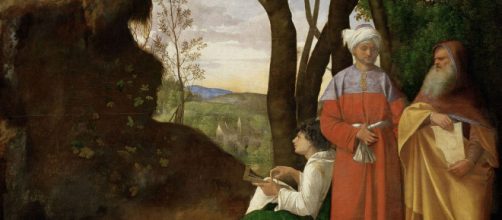“Show, don't tell” – an unwritten writing rule that says sensory description rather than explanation empower readers to experience a story for themselves – was modeled in Anton Chekhov’s letter to his writer-wannabe brother Alexander: “Don’t tell me the moon is shining. Show me the glint of light on broken glass.”
Can this writing rule be applied to painting? If it’s true that pictures are worth more than a bunch of words, yes. Renaissance painter Giorgione makes the case by letting his imagery do the talking.
“The Three Philosophers,” loaned by the Kunsthistorisches Museum in Vienna to the Frick Collection in New York, suggests that whatever this work is about is up to the viewer.
Old habits die hard
Of course, the Frick Collection does what museums do; it cites a scholar’s view of the painting – Marcantonio Michiel description written in 1525: “A painting in oil of three philosophers in a landscape, two standing, and one seated who contemplates the rays of the sun, with an admirably rendered rock.”
You don’t need a scholar to tell you that. Besides, Michiel missed the most noticeable thing about “The Three Philosophers.” Even though it was painted during the Renaissance, it’s not about history or mythology or religion – all subjects Giorgione’s contemporaries did and did and did.
In the very same year that Giorgione painted “The Three Philosophers” (1505), Raphael painted “Madonna del Prato” – a vision of the Virgin Mary gazing upon two children, Jesus and his cousin John the Baptist.
Compared to Raphael and so many others in Giorgione’s generation, his secular works were so different, they confused scholars. Art historian Giorgio Vasari complained, “There are no scenes to be found with any order.”
Clearly, Vasari failed to notice that the so-called lack of “order” in Giorgione’s picture freed his imagination to make up his own story.
Giorgione’s “The Tempest” is another work that Vasari and other scholars were at a loss to know what to do with. What you see is nude female nursing an infant on a riverbank. From a distance, a soldier stands watchfully. On the other side of the river a town stands along with a distant landscape.
Art historian Sister Wendy Beckett acknowledges in her 1994 book “The Story of Painting” that “The Tempest” is “the most argued over work in existence.”
But that’s a good thing, isn’t?
It means that Giorgione freed us to think for ourselves. And he kept doing it. Another example is “Concert Champetre.”
Let freedom ring
This painting offers a picnic scene with two clothed men and two nude women, one playing a lute, all of which beg questions that forever go unanswered. The answer is up to the viewing public. Apparently, this makes scholars nervous.
Vasari, who chronicled the artist’s life after he died prematurely of
the plague, went around asking Giorgione’s friend Titian and others what they thought his paintings meant and got nowhere, saying:
“I, for my part, have never been able to understand his figures and for all my asking have I ever found anyone who does...Heaven knows what it all means.”
Really, Giorgio?
Nothing came to mind? Some things are self-evident, if you just look. Even a casual glance at “The Three Philosophers” shows that the figures represent different generations – young, middle aged and old.
And, since thinking varies as one ages, can it be that Giorgione was pointing this out, saying to his fellow Renaissance painters that their fixation on religion or history or mythology isn’t all there is to paint?
One possible take-away from “The Three Philosophers” is that the two older figures are so steeped in discussing the books they carry that they fail to notice the world around them the way the younger figure does.
But you could also hold the opposite view and see the younger figure as disregarding the learning in the book he holds to daydream while his elders remain diligent.
If the lesson is to show rather than tell, then the younger figure does the telling, don’t you think? Or is it the older figures who do? Or is there another possibility?


